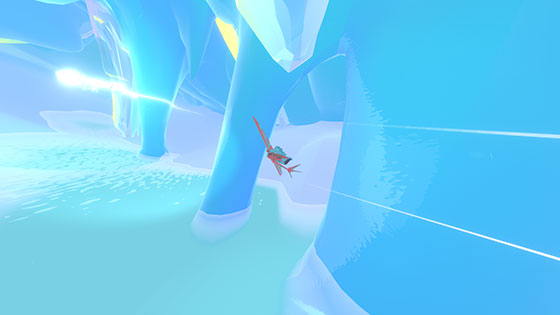‘InnerSpace’ Review (Nintendo Switch)

With the still-painful memory of No Man’s Sky still firmly embedded in the cerebral cortex of many gamers, InnerSpace seems destined for a rough ride and possibly, a hard landing. Billed as the latest flight-exploration game and produced by relative newcomers PolyKnight Games, Innerspace has at the very least avoided the same kind of ridiculous build up that caused No Man’s Sky so much trouble.
InnerSpace has more focussed, modest objectives than the 2016 epic from Hello Games. Instead of featuring a procedurally generated galaxy that is filled with worlds that are as likely to be bland and bleak as they are to be filled with wonder, Innerspace delivers a more linear experience that unfolds across tightly designed bubble worlds. Each sphere is an exploration puzzle of sorts, and players must navigate one of their fragile airframes through caverns, crevasses, oceans and a variety of other obstacles.
Each world has its own boss – a godlike entity that is usually defeated (or released) in an abstract way, rather than through force. Whilst Innerspace uses really tight, simulation style flight controls (the left stick controls flight axis, whilst the right controls speed and tilt), it doesn’t have any combat as such, hence the flight-exploration moniker. Most worlds feature a few abstract puzzles that bar progress until the player has reached a specific event or followed a set course, although the signposting for these triggers is unfortunately fairly poor.
Visually, InnerSpace is quite an achievement, especially when played on the Nintendo Switch’s handheld mode. The pastel-hued graphics are excellent and do a very good job of bringing the overall creative vision to life. Each spherical world is based on the concept that gravity works in the opposite direction to how we understand it, meaning that seas form on the outside edge, whilst mountain ranges climb towards the centre. Placing your undivided attention on the small, clear screen is hugely immersive.
Whilst the worlds are undoubtedly the central attraction of InnerSpace, the game has a whimsical but nonetheless engaging narrative built around collecting the memories of these now forgotten worlds. Achieving this is done by seeking out relics in the various spheres, each of which can then be researched by the archaeologist who acts as both narrator and translator, providing the player with insight into what befell each world (should you be interested.)
Ultimately, InnerSpace is a great addition to the ever expanding library of Switch games, offering an experience that is not unlike a walking simulator, but with the addition of a lot more technical elements – plus of course the threat of crashing or being defeated by a boss. On that note, the highly stylised visuals are not the best when it comes to navigating tight locations, so it’s sometimes possible to feel a little bit cheated. The optionality of relics and some of their hiding places offers replayability for completionists, so all said, InnerSpace is a satisfying purchase.
***½ 3.5/5











































